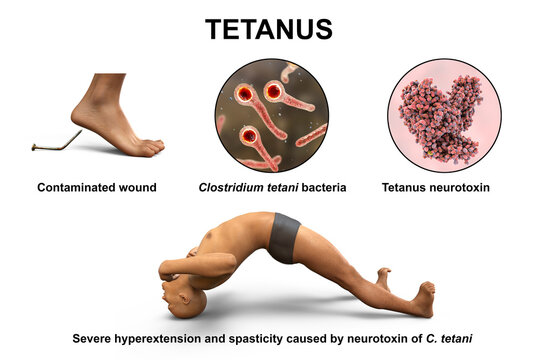Nursing Paper Example on Tetanus
/in Assignment Help, BLOG, Homework Help /by Aimee GraceNursing Paper Example on Tetanus
Tetanus, often known as “lockjaw,” is a serious bacterial infection caused by Clostridium tetani. This bacterium produces a neurotoxin that affects the nervous system, leading to painful muscle contractions, typically beginning in the jaw and neck muscles. Tetanus can be life-threatening without prompt treatment, especially when the respiratory muscles are affected. This condition is preventable through vaccination, yet it continues to cause significant morbidity and mortality in areas with limited vaccination coverage.

Pathophysiology
Clostridium tetani is an anaerobic, spore-forming bacterium that thrives in soil, dust, and animal excrement. When introduced into the body through open wounds, the spores transform into active bacteria and release tetanospasmin, a potent neurotoxin. This toxin binds to peripheral nerves and travels to the central nervous system, where it inhibits the release of inhibitory neurotransmitters, including glycine and gamma-aminobutyric acid (GABA). The resulting imbalance causes muscle spasms and rigidity, which are the pathognomonic signs of tetanus (Centers for Disease Control and Prevention [CDC], 2023).
Causes and Transmission
Tetanus is not transmitted from person to person. Instead, infection typically occurs through:
- Contaminated Wounds: Puncture wounds, burns, lacerations, and even minor scratches contaminated with soil, dust, or animal waste are common entry points.
- Unsterile Medical Procedures: In regions lacking proper medical supplies, contaminated equipment can introduce tetanus spores.
- Injecting Drug Use: Using unsterile needles can lead to spore transmission.
- Neonatal Tetanus: Infants can contract tetanus when the umbilical cord is cut with contaminated tools or in unsanitary conditions (World Health Organization [WHO], 2022).
Signs and Symptoms
Tetanus symptoms generally appear within 7–10 days of exposure but can range from 3 days to 3 weeks. Symptoms include:
- Trismus (Lockjaw): Stiffness in the jaw muscles, making it difficult to open the mouth.
- Neck and Back Stiffness: Muscle rigidity extends to the neck and back.
- Spasms and Rigidity: Painful muscle spasms, often severe, in the chest, abdomen, and limbs.
- Difficulty Swallowing: Muscle spasms in the throat may make swallowing difficult.
- Opisthotonos: Severe cases may result in an arched back due to sustained muscle spasms (CDC, 2023).
Severe spasms affecting respiratory muscles can lead to respiratory failure, the primary cause of death in tetanus patients.
(Nursing Paper Example on Tetanus)
Diagnosis
Tetanus diagnosis is primarily clinical, as no specific lab test is available. Doctors often base the diagnosis on:
- Patient History: Especially noting recent wounds, unvaccinated status, or injection drug use.
- Physical Examination: Evaluating the characteristic symptoms, such as muscle stiffness and spasms.
- Differential Diagnosis: Conditions like meningitis, rabies, and dystonia must be ruled out through neurological examinations and, if needed, imaging studies (Mayo Clinic, 2023).
Treatment Regimens
Tetanus treatment is focused on neutralizing the toxin, controlling muscle spasms, and supporting vital functions:
- Tetanus Immune Globulin (TIG): Administered to neutralize circulating tetanospasmin in the body. TIG is most effective when administered early.
- Wound Care: Cleaning the wound thoroughly to remove any remaining C. tetani spores is essential.
- Antibiotics: Drugs such as metronidazole are used to kill C. tetani bacteria and prevent further toxin production.
- Sedation and Muscle Relaxants: Benzodiazepines, like diazepam, are used to manage muscle spasms.
- Ventilatory Support: In severe cases, patients may need mechanical ventilation until muscle rigidity decreases and breathing improves (World Health Organization, 2022).
Complications
Tetanus can result in serious complications, particularly if untreated:
- Laryngospasm: Sudden muscle spasms in the larynx can obstruct the airway.
- Aspiration Pneumonia: Difficulty swallowing can lead to aspiration and subsequent lung infection.
- Fractures: Intense muscle spasms may cause bone fractures.
- Autonomic Dysfunction: Severe cases can affect the autonomic nervous system, leading to blood pressure fluctuations, arrhythmias, and cardiac complications (Mayo Clinic, 2023).
Prevention
Tetanus is preventable through immunization. The tetanus toxoid vaccine is usually administered in combination with diphtheria and pertussis vaccines (DTaP for children, Tdap for adolescents and adults). The vaccination schedule typically includes:
- Primary Series: Administered in infancy with booster shots at 2, 4, and 6 months, then at 15–18 months and 4–6 years.
- Booster Shots: For adults, a booster dose is recommended every 10 years. Additionally, booster doses may be given following injury in individuals whose last dose was over 5 years prior.
Effective hygiene practices and wound care further reduce the risk of tetanus, particularly in areas with limited vaccine access.
Prognosis
The prognosis for tetanus patients depends on the severity of symptoms, timeliness of treatment, and age. The mortality rate is significantly higher in individuals with severe, untreated tetanus, as well as in neonates with neonatal tetanus. However, early intervention and supportive care can lead to complete recovery in many cases.
(Nursing Paper Example on Tetanus)
Conclusion
Tetanus remains a preventable yet severe disease, especially in regions with limited healthcare access. Despite the availability of an effective vaccine, cases still occur, underscoring the importance of vaccination campaigns and education. Timely diagnosis, prompt wound care, and treatment play crucial roles in improving outcomes for individuals with tetanus. As vaccine initiatives expand, there is hope that tetanus incidence will continue to decrease, protecting more individuals from this debilitating and often life-threatening disease.
References
Centers for Disease Control and Prevention (CDC). (2023). Tetanus: Signs and symptoms. https://www.cdc.gov/tetanus/symptoms
World Health Organization (WHO). (2022). Tetanus. https://www.who.int/health-topics/tetanus
Mayo Clinic. (2023). Tetanus: Diagnosis and treatment. https://www.mayoclinic.org



